|
In memory of my son Olof jr |
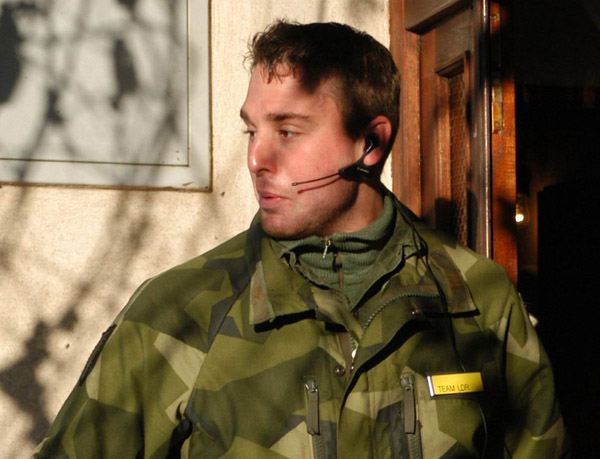 |
Text by O. Janson
This webside is dedicated to my late son Olof.
My special regards to
Per Holmback and
Ingemar Karlmark
who has supported this article with facts and some pictures about the rare Swedish
Field knives.
|
In memory of my son Olof jr |
 |
| Denmark Military |
| Sweden |
| MORA standard knives |
| MORA the First Fighting knife TEST |
| French M1916 |
| FM/52 S The Swedish US M3 |
| FM/52J |
| US Influence |
| fm/54 |
| fm/56 |
| fm64 |
| Bayonet m1965 |
| Survival knives |
| Fallkniven Survival knives |
| Multipurpose knives |
|
Swedish Fighting knives - Field knives pictures by O. Janson
|
|
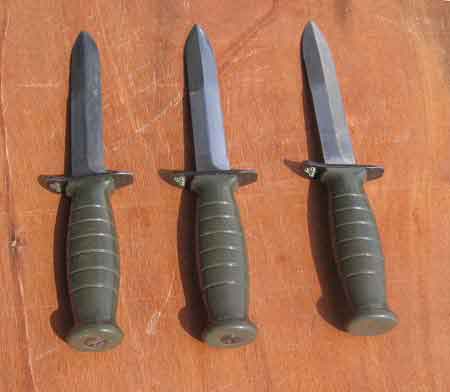 |
This webside is dedicated to my son. My special regards to
Per Holmback,
|
|
Swedish fighting knives - Field knives pictures by O. Janson if nothing else not stated.
|
|
Trials for a Swedish Fighting knifeMilitary knives can be devided into diffrent categories. Any knife can be used for knife fighting to kill an enemy, but to be suitable for fighting the knife should have double edges at least for the part called false edge. One of the fighting knives
tested was the French knife M1916 from the Great war “Le Vengeur de 1870”
(The Avenger of 1870). It became one of the first real fighting knives used by the Swedish Airborne forces for evaluation. The original scabbard of steel was replaced by one made by leather to make a smooth silent draw. |
 |
|
“Le vengeur de 1870” One of the knifes from Norway which came to Sweden. Private collection |
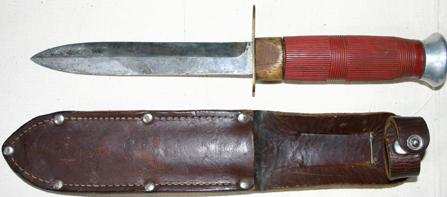 |
FM/52J has
the typical type of blade similar to M3 fighting knife. This type of blade
is used in the Swedish forces from FM/52J up to present with the bayonet
M1965 for the Assault rifles AK4 and AK5 Pictures Ingemar Karlmark
|
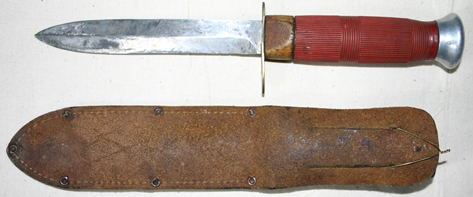 |
It was a very simple construction: Grip - A wooden grip from birch covered by a red rubber sleeve like for a handle for a bicycle. The scabbard was made of leather like for a hunting knife |
 |
The crossguard was made from thin brass and marked with 1952 and P.H. (for Pontus Holmberg in Eskilstuna). |
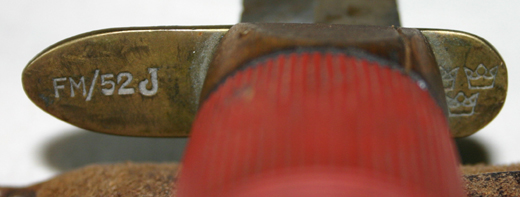 |
The crossguard
was marked with FM/52J
|
|
Swedish Army manual about knife fighting Here below is a page from one of the rare instruction manuals from
1956. |
|
|
Compare the hold of the knife with the Fairbairn-Sykes technique.
|
|
Please notice the difference between the Swedish Army
manual above and Fairbairn-Sykes system. |
|
|
Here
illustrated in "Kill or get killed" by Col. Rex Applegate. |
The Swedish Army was influenced by the development in US.
| The influence on
the Swedish military from USA was very obvious at this time. The Swedish
military looked for something similar to the US fighting knife M3 or US
bayonet M4. |
The mother of the the Swedish Field knives - US M3 Fighting knifeThe demand for a fighting knife in USA became apparent with the use of the submachine guns. There were many soldiers missed the bayonets of the rifles and for this reason they needed a knife.
Typical for the M3 is the rather thin blade. A wide blade will consume a lot of iron and be expensive to produce at large numbers. The M3 is a simple construction very much like the MARINE Corps knife. The M3 had a carbon steel blade, leather stacked washer handle, full steel cross guard. The guard was made of thick steel and angled at the top as a thumb rest. The blade was parkerized and 6 ¾ inches long and the overall length was 11 ½ inches. It had a single sharp edge with about one third of the false edge sharpened.
|
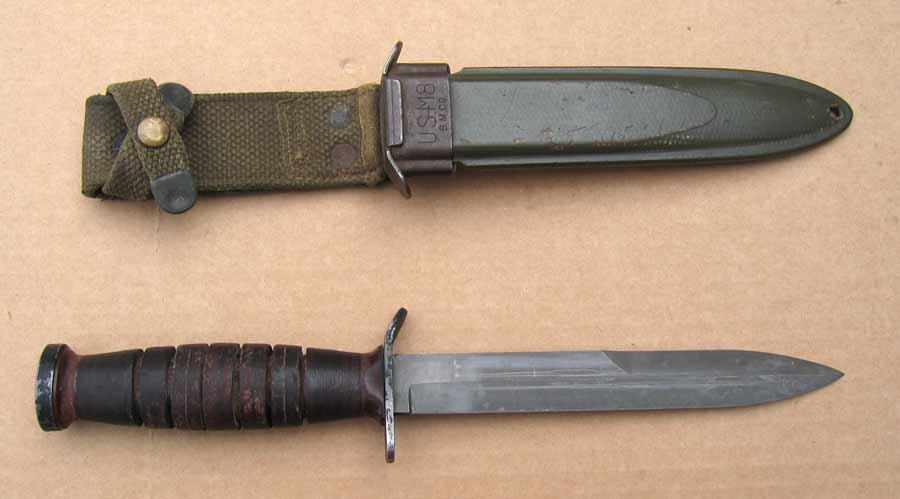 |
| Here is the famous US M3 fighting knife. Private collection |
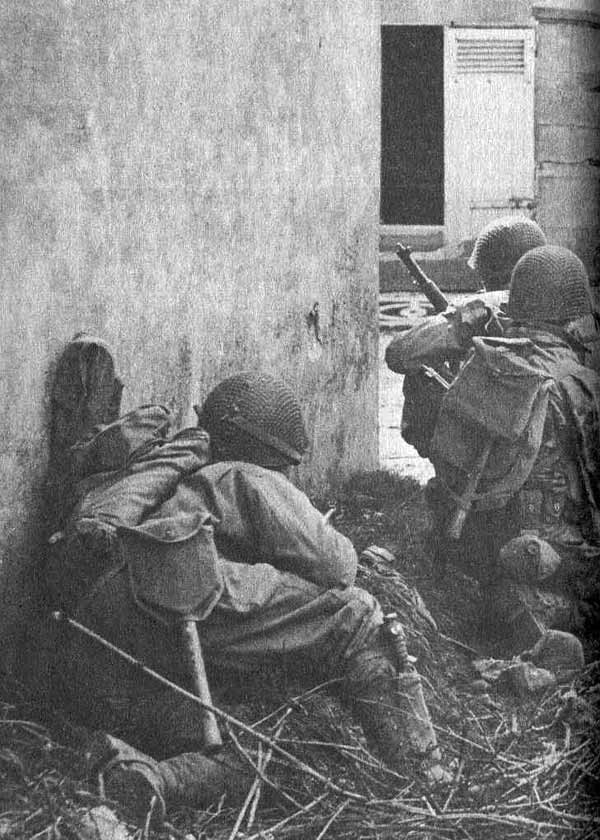 |
Note the soldier close to the camera. He has a M3 strapped to his right leg. |
The M3 trench knife was officially standardized on January 14, 1943. It was only made for 17 months and the amazing production was 2 590 247 knives!
|
|
| Specifications | M3 |
Length over all |
295 mm |
Length of the blade |
170 mm |
| Wideness of the blade | 22 mm |
Thickness of the blade |
4,6 mm |
Wheight |
240 gram |
The bayonet M4 replaced the M3.
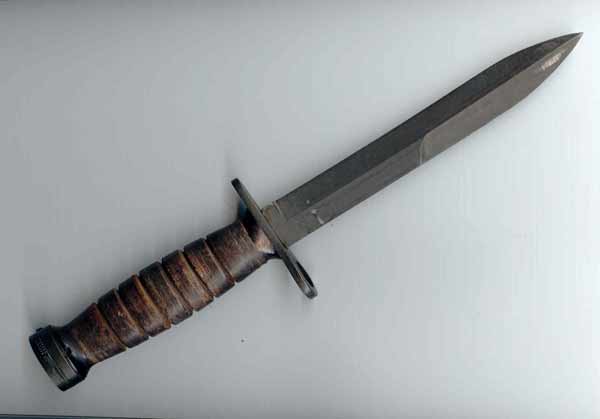 |
US bayonet M4 of an
early production. (Private collection) |
And as you can see the Swedish test sample here from
1952 made by Pontus Holmberg,
which you can above in the text also

| The Field knife fm/54 | |
|
Now the main development of fighting knives was overtaken by a factory in Eskilstuna by the name of Erik Anton Berg AB (EAB). 1954 some test models were by this factory. There are reports with different types of handles. Some were welded to the tong while some were fixed with rivets. Sweden called this type of fighting knife "Field knife" (faeltkniv). |
|
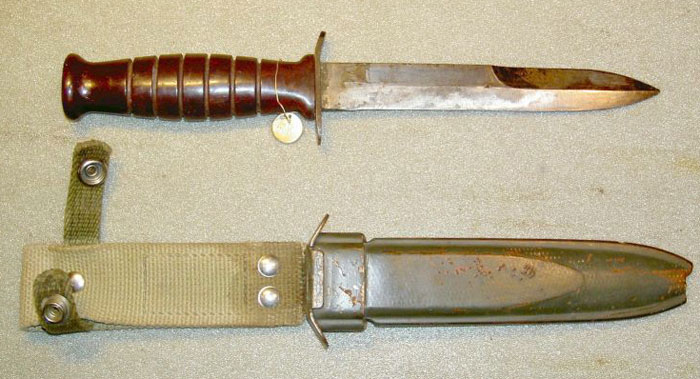 |
|
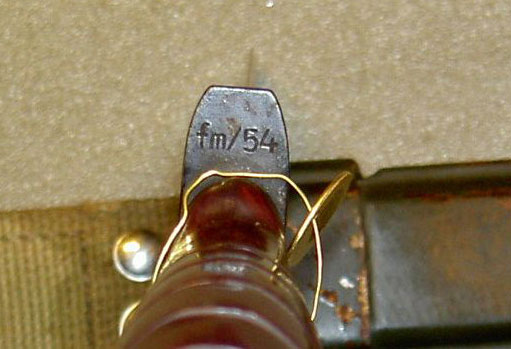 |
Above and
to the left is the fm/54 Pictures from Per Holmback |
 |
| FM/54 fanns i många färger
(bild ovan från Armémuseum)
|
 |
| FM/54 (bild ovan
från Per Holmbäck)
|
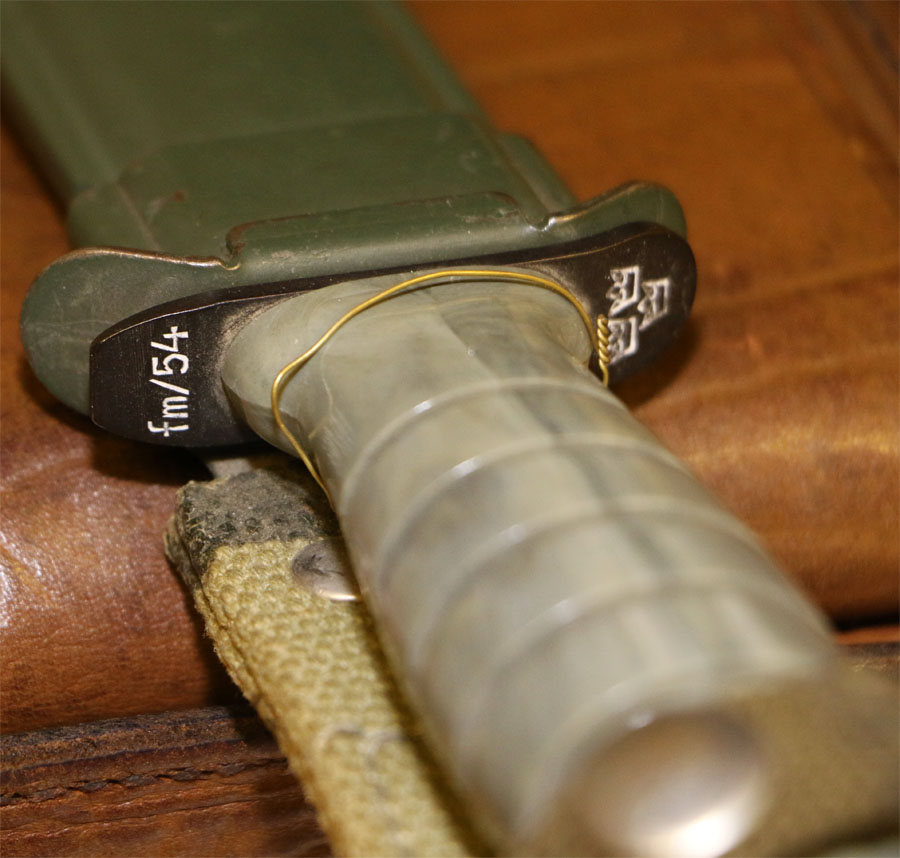 |
|
The
Field knife FM56.
1956 there was another model brought out for testing called fm/56. It was also produced by E. A. Berg.
|
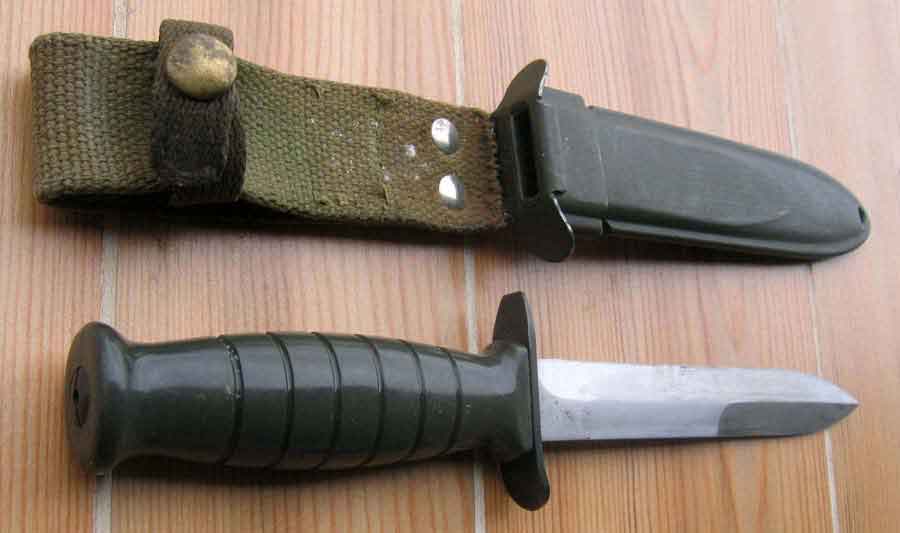 |
|
Swedish fighting knife - Field knife FM56
|
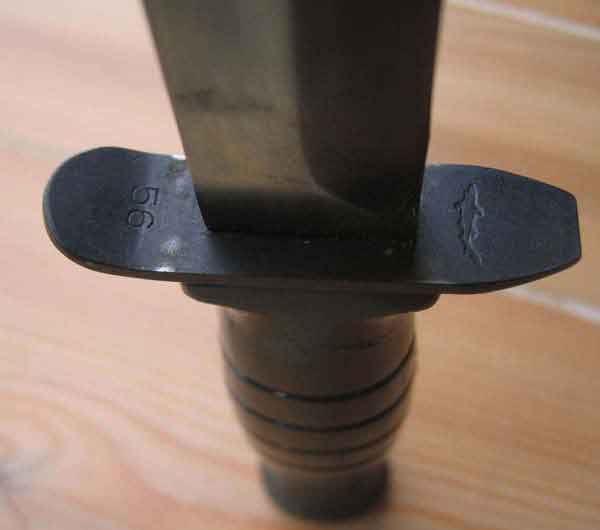 |
Here you can note two marks: The shark for E.A.B. and 56 for the model. on the crossguard. (Pictures Private collection) |
|
|
FM56
Here is the flat recessed
pommel nut, (Picture Private collection) |
|
Fältkniv FM56.
1956 togs det fram en ny modell för utvärdering och den kallades fm/56. Den tillverkades av E. A. Berg.
|
| Many of these knives had ordinary US M8A1. The stamping was simply coverd by a thick layer of green paint! |
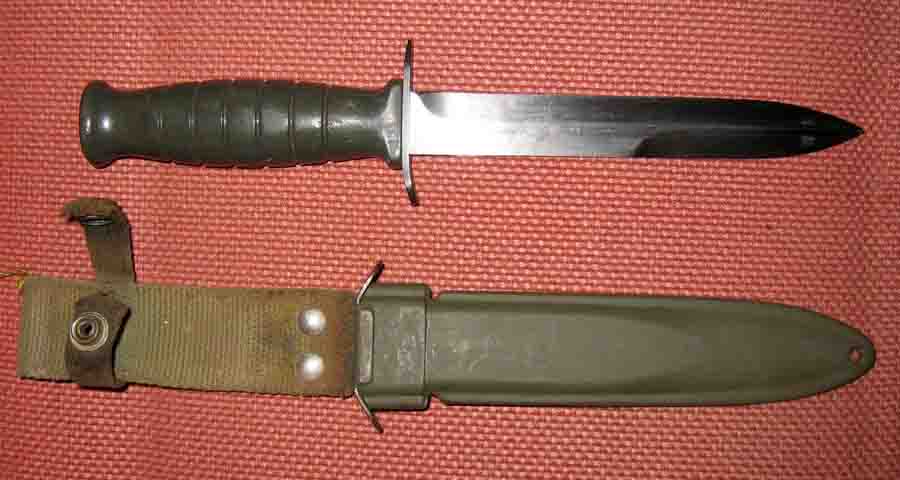 |
 |
|
Fältkniv fm/56 |
|
The Field knife FM64. |
|
The last
knife in these series of test was called fm/64.
It looks
exactly the same from the side as fm/56.
|
|
|
|
|
Above Top - FM/56 The only differences between fm/56 (left) and fm/64 (right) are the markings and the pommel nut, which locks on to the tang. The integral pommel of the fm/64 is a better design. 1964 the Swedish made scabbards were introduced. They were brown made of plastic but looked like wood. Note the three crowns for Sweden. Picture Private collection |
| The end result was the Swedish fighting knife test model 1964 which you can see here. |
|
|
|
|

|
|
| Above Swedish model 1964
with a scabbard made of wood imitation. It was delivered in a cover made of
paper marked with 3 crowns Picture Private collection |
|
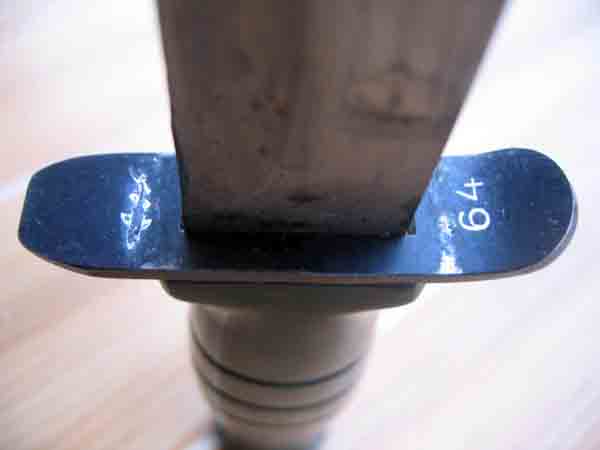 |
Here is the crossguard.
The Shark - the logotype of the Swedish company - E A Berg AB in Eskilstuna. E.A.B. was bought by Bacho in 1959. 64 for the model and the three crowns for Sweden. Picture Private collection |
| According to Per Holmback there might have been made some
300 of these knives FM64. Most likely these FM/64 were never used for
trials. Those you find are in excellent unused condition. The field knives
were replace by the AK4 bayonet 1965.
|
|
| Specifications | Fieldknife FM56 and 64 |
Length over all |
285 mm |
Length of the blade |
165 mm |
| Wideness of the blade | 23 mm |
Thickness of the blade |
5 mm |
Wheight |
220 gram |
Scabbards
|
I |
|
Top Swedish FM 64 scabbard wood imitation, Middle Swedish FM65 scabbard, Bottom U.S. M8 scabbard |
|
First Sweden bought the M8 scabbard from USA for the Field knives. The marking M8A1 was normally just covered by heavy green paint! When the FM64 was introduced it appeared with the same type of scabbard but now it was brown made of wood imitation. This significant type of scabbard still remains in the army with the bayonet 1965 scabbard.
|
|
In some respects the Swedish Field knives reminds about the early Colt M7 bayonets. You can see one of these below. (Picture from Per Holmback) |
|
|
| The fighting knife of today for the Swedish forces. |
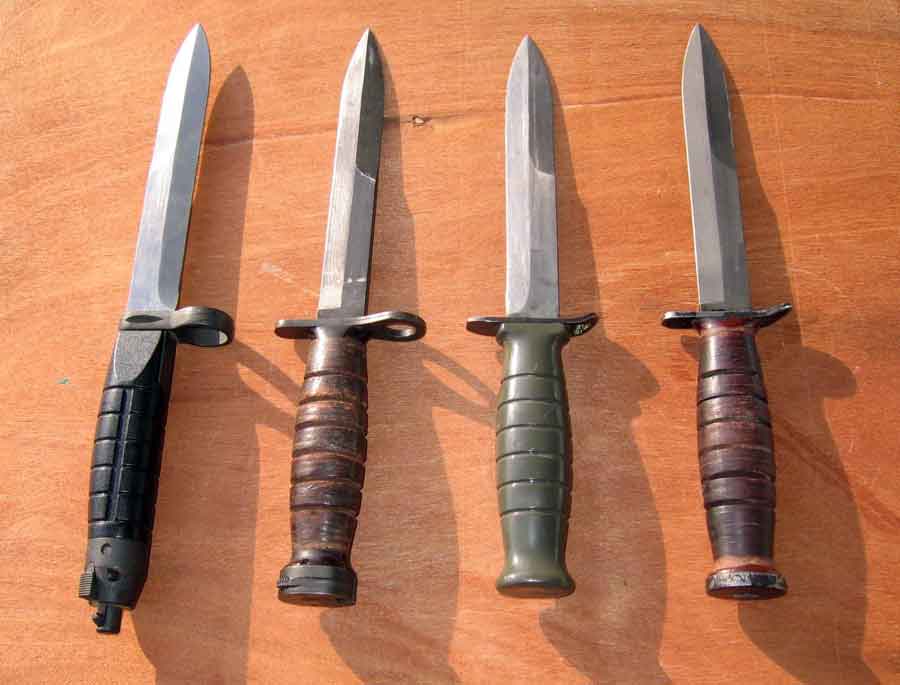 |
| The development in Sweden
followed the development in USA. First a pure fighting knife and later back
to a bayonet. Picture Private collection From left to right:
It is clear that the influence came for the Swedish knives came from USA. The M3 and the Swedish field knives are very much looking alike. These fighting knives and bayonets are all using the same type of blade. |
Swedish Bayonet model 1965
|
1965 Sweden started to produce a new assault rifle H&K G3 called Ak4. It was equipped with a bayonet made by the Swedish company Bacho. Even this bayonet has a blade and scabbard which resembles the M3 and all other US modern bayonets up to US M7. The specifications for the blade are identical with the field knife 64 The bayonet for Ak4 is nowadays used by all special forces in Sweden as fighting knife. It can be seen here used by KFOR military in Kosovo. The soldiers on the picture were trained as commandos in Sweden. |
|
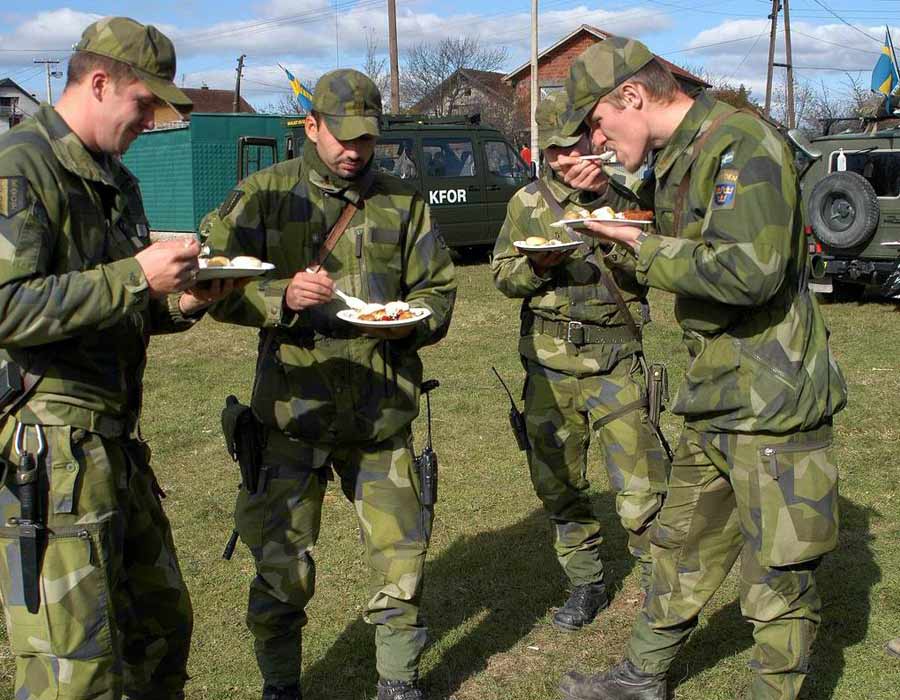 |
|
| Note the soldier to the left, with bayonet used as a fieldknife, which is easy to reach to. (Picture O. Janson) | |
|
|
Bayonet 1965 for the
assault rifles Ak4 and Ak5 Note the obvious similarity of this scabbard compared to the U.S. M8 scabbard shown before in this article..
(Private collection) |
|
|
Crossguard
of the 1965 bayonet. Please note |
| Specifications | Bayonet model 65 |
Length over all |
310 mm |
Length of the blade |
166 mm |
| Wideness of the blade | 23 mm |
Thickness of the blade |
5 mm |
|
|
|
SWEDISH ARMY KNIVES
Utility knives from MORA
|
Sweden has a long tradition of making knives. The most commonly used knives used in the Swedish forces are the ordinary Mora knives. The story behind the Swedish well known knives of Mora. The life was very poor for the farmers in the area of Mora during the 18th century. You will find the town Mora in the centre of Sweden in the middle of vast forests. The farmers during the 18th century had to find themselves complementary ways of living. It was during those circumstances that Erik Frost Eriksson started to produce knives. Later on he started in his factory 1891 to produce what we today know as the knife from Mora or Mora knife. The factory is still remaining in a small village called Ostnor. His company made a lot of different utilities from steel in the beginning, like tools for the forest like an ordinary blacksmith. Around 1900 the knife had been so popular that the production of it became the main article. The steel in the old “original” knives came from Vikmanshyttan and some other Swedish steel producers. The grip was made out of birch which came from Småland some 400 km south by Mora. The scabbard was made of millboard which was decorated in different patterns. The scabbard were made in Tidaholm, which you will find some 360 km south by Mora. Once upon a time there were lots of producers who copied the knife of Erik Frost. Some of these where companies were Krang Johan Eriksson (KJ Eriksson), the brothers Jonsson, F.M. Matsson (FMM) and Bud Carl Andersson. (CA Mora). These companies, although they were making competition to each others, also supported and helped each others. They were all situated within a small area close to the town Mora. They disappeared one by one and now Mora of Sweden is the only remaining company. Today Mora of Sweden produces some 250 different models in Ostnor. Today the steel is stamped out of the steel from Sandvik 12C27, which is the same steel like KaBar used in their “Next Generation Fighting Knife”. The grip is normally made from plastic like the scabbard, but still you can buy from them the old style carbon steel knives with red wooden handles. You will find them here: http://www.moraofsweden.com/index.php?id=18
The Mora
knife is a traditional knife normally made from laminated carbon steel with
a single edge.
|
|
|
|
These are some ordinary knives from Mora used by the Military.
Note the acceptance mark - three crowns.
Private collection |
 |
|
Above:
|
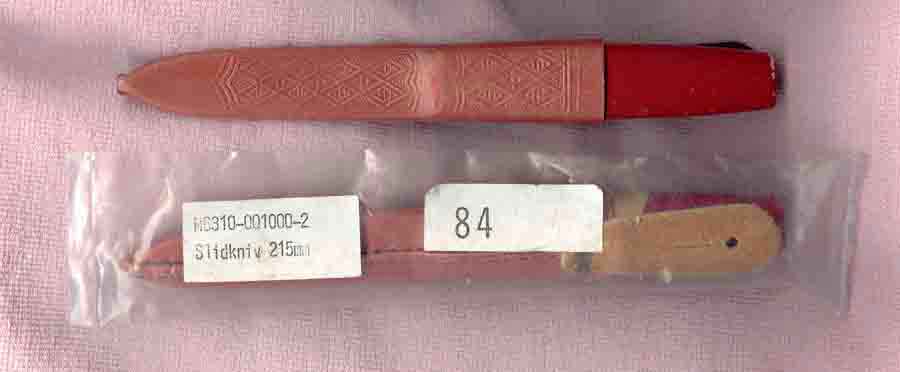 |
|
Same medium as above but new in plastic
wrapping with military marked:
|
 |
Carl Andersson (CA) which was sold 1961 to KJ Eriksson |
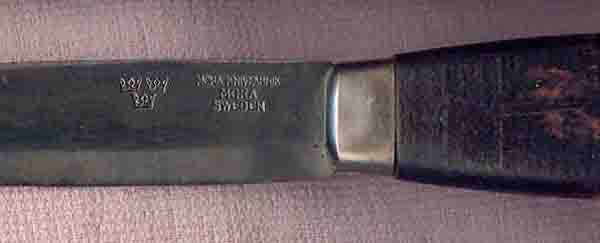 |
MORA KNIVFABRIK |
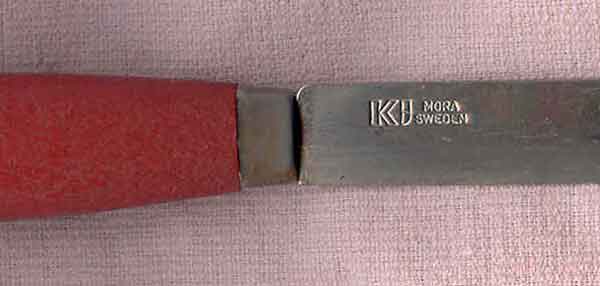 |
KJ Eriksson, founded 1912 |
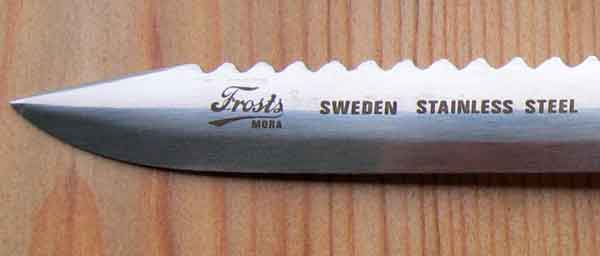 |
Frosts AB, founded 1891 |
|
Nowadays MORA OF SWEDEN. Since 2005 KJ Eriksson bought the shares of Frosts AB and became one single company called Mora of Sweden AB although the logotype “Frosts” will still appear in the future on some knives.
|
|
Other Utility knives used by the military forces of Sweden.The Swedish troops are often equipped with ordinary knives like the “Mora” or at the beginning of this article. Some models are preferred and have acceptance marks. Since 1970s this is a Model-number like M6310-xxxxxx. M6310 tells us that it is a knife. BACHO made another knife around 1970 which was accepted and used by the military. It became popular with artillery and some other units during this period because it was more versatile because of its wide blade, which made it suitable for using it for cutting and chopping. |
|
The Bacho survival / hunting knifeThe Bacho survival / hunting knife is made from stainless steel and a grip made from welded plastic. The scabbard is made from the same material. On the backside of the scabbard there is a honing stone. The scabbard has a steel wire clip for attachment to i.e. a boot. The scabbard is open in both ends to let all snow and humidity pass through.
|
|
 |
|
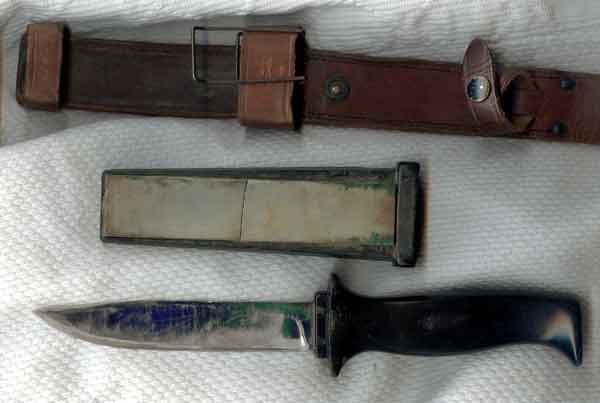 |
Notice the wire clip and the honing stone. (Private collection) |
| Here is the Bacho knife which I used myself during my military service in the artillary. | |
| 1995 some army units accepted the model A1 as Swedish survival knife made by Fallkniven AB. (Link to Fällkniven ) |
|
|
Above A1 |
| It is free for the Swedish soldier to use any type of knife as long as it is not "too offensive".
|
| Specifications A1 | |
Length over all |
280 mm |
Length of the blade |
160 mm |
Thickness of the blade |
6 mm |
Wheight |
305 gram |
|
Military EKA folding knife
|
|
|
Some of
the mechanical army brigades has this folding knife from
EKA in Eskilstuna. |
|
 |
|
|
|
The folded EKA knife (Private collection) |
 |
The folding EKA knife
|
|
A later made EKA 60 (picture Jesper.L)
EKA38 mib with manual (picture Jesper.L)
|
|
Small
and big. The big green knife with blade lock and the smaller blue folding
knife without blade lock. |
|
|
Swedish Air Force utility and survival knives Follow this link to see and read about the knives used by the Airforce. |
|
Multipurpose Leatherman Crunch This multipurpose Leatherman Crunch has been used by the Swedish KFOR in Kosovo. |
|
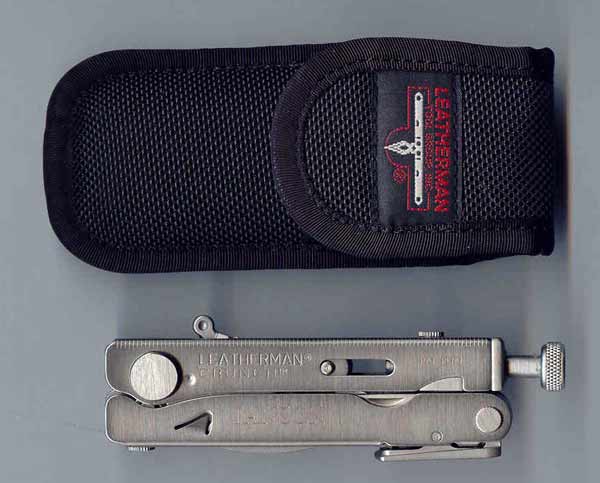 |
Length:
4 in. / 10 cm closed
(Engraved with name) (Private collection) |
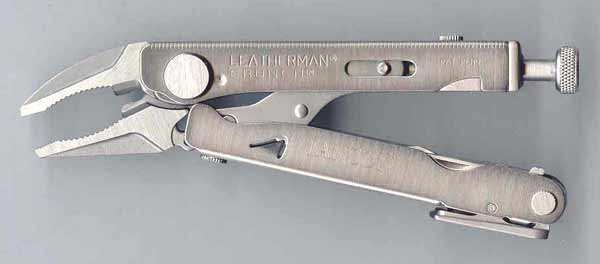 |
Multipurpose
isn't it?
Locking
Pliers |
| References: |
| Military knives - Knife World Magazine ISBN 0-940362-18-X |
| Frederik J Stephens - Fighting knives ISBN 0-668-04955-3 |
| Per Holmback |
| Hutte Benckert, SVEVAP, Stockholm, Sweden |
| Cpt Arne Larsson, Gothenburg. |
| Fallkniven AB |
| Mora of Sweden AB |
| Military officers from Karlsborg, Sweden |
| Handgemäng 1956 - The Swedish army 1956. |
Åter till hemsidan om alla blankvapen
|
Åter till
|